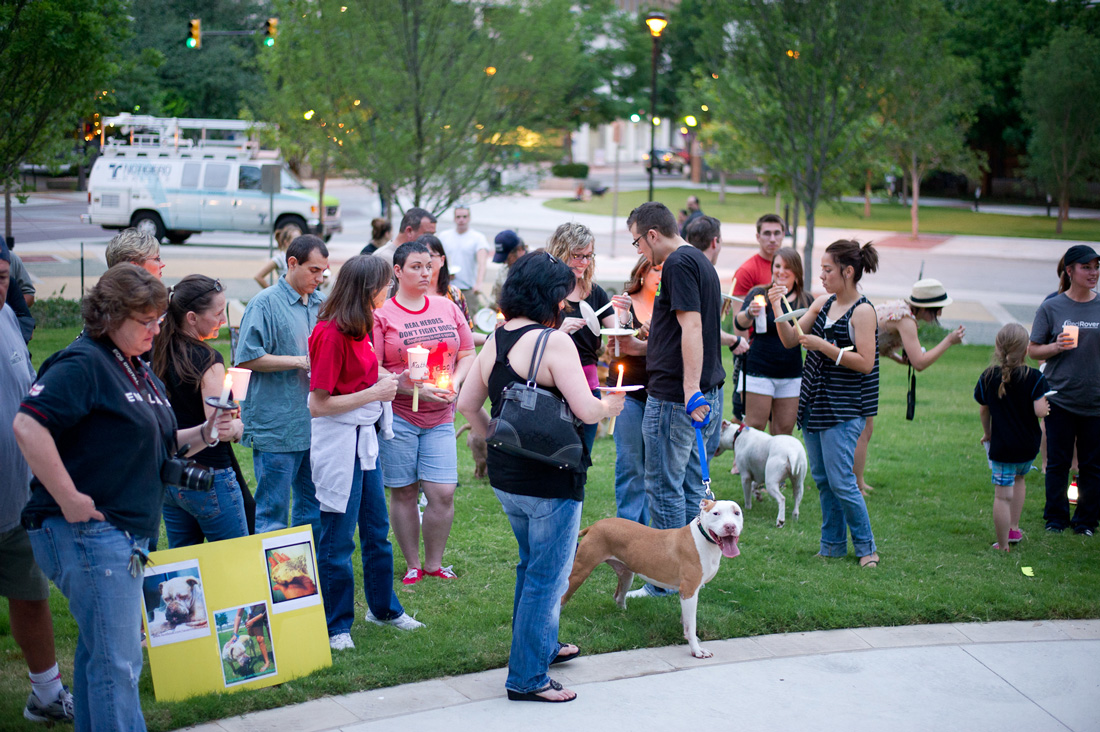The pit bull’s wounds were so ghastly that his rescuer was instantly moved to tears.
His snout had been torn to ribbons, his bottom lip ripped off the bone, and his tongue lacerated in multiple places. The infection was so severe you could smell it from 20 yards away.
As soon as Judy Obregon saw the pit bull’s photo on the Fort Worth Animal Shelter website, she picked him up and rushed him to a veterinary clinic.
But it was too late for Nathan, as Obregon named him. He died in surgery.
“It was another large dog that did this,” veterinarian Barry Chaikin said. “Whether it was another pit bull, whether it was some type of an organized fight, I can only speculate. But this wasn’t just one bite. It was repeated bites.”
For Obregon, who’s spent the last several years rescuing pit bulls from the city shelter and from neighborhoods in south Fort Worth, Nathan was only the latest and most extreme example of organized dog fighting in Cowtown.
That’s hard to prove, as Obregon is quick to acknowledge. But in recent months, she’s found two dead pit bulls left in garbage bags by the railroad tracks, another dead from bites to its neck, and many strays with wounds to their legs, faces, and ears –– all from the same area south of Morningside Park.
In Arlington and Everman, rescue groups and veterinarians said they often see the same thing.
The people who organize and participate in dog fighting are notoriously difficult to locate, much less catch in the act. But Obregon said her requests for investigation by the city’s police and animal control departments have been largely ignored.
She said that when she has called police about abused dogs, she’s been told that animal cruelty is “not a priority,” and animal control officers often don’t show up to investigate until days later. On many occasions, she said, she has called animal control about stray dogs only to find the animals still running loose days later, so she takes them to the shelter herself.
Fort Worth Animal Control Officer Jay Sabatucci said the department investigates all complaints and that it takes reports of dog fighting “very, very seriously.” Sgt. Pedro Criado, spokesman for the Fort Worth Police Department, declined to comment. He told the Weekly to file a public records request for the information, which can take more than two weeks.
That attitude is what Obregon has been dealing with for months, she said.
“You cannot see an organized fight if you don’t investigate it. I keep going back to the same area and finding dogs with serious wounds. This shelter is getting two dogs a week with wounds that suggest dog fighting,” she said.
Sabatucci disputed that. He’s worked at the shelter for almost a year and said he’s seen few, if any, dogs with injuries that suggest organized dog fighting.
He should know. Sabatucci formerly was the Texas director for the Humane Society of the United States and specialized in investigations of animal fights. Most wounds could be the result of stray dogs fighting each other in the street, he said.
Sabatucci said he’s out in Fort Worth neighborhoods all the time, and he isn’t seeing the kind of evidence he would expect if the city had a dog-fighting problem. Usually, dog fighters will have 20 or more pit bulls chained up and equipment lying around, he said.
“Every major city has dog fighting going on somewhere,” he said. “Is it a major problem here? No.”
In the last two and a half years, he said, animal control has received 35 reports of dog fighting, but most were random –– nothing organized.
But the low numbers aren’t that surprising, said Tammy Roberts, a cruelty investigator for the Humane Society of North Texas. Dog fighting isn’t a high priority for local law enforcement, which is why it continues to be common nationwide, including in North Texas, she said.
The payoff may seem low for the amount of effort involved: Texas has some of the weakest dog-fighting laws in the country, according to the Humane Society.
Watching an organized fight and possessing dogs for fighting are misdemeanor crimes with a maximum sentence of one year in prison and a $2,000 fine. Participating in a fight or running a ring is a state felony, which, upon conviction, carries a maximum penalty of four years in prison and a $5,000 fine. In New Jersey, by comparison, those crimes carry fines as high as $15,000 and up to five years in prison.
Every month, Roberts said, she sees one or more dogs that were in organized fights surrendered to local shelters, and they’re nearly always pit bulls.
“I know it is happening,” she said. “Proving it is a different story. It takes a lot of help from law enforcement and a lot of man-hours. The hard part with dog fighting is that backyard fighting isn’t typically very organized, so it’s very hard to catch them in the act of an actual dog fight.”
The dogs turned over to shelters by rescue groups likely represent only a small percentage of the animals involved, Roberts said. They are the dogs that escaped or were abandoned because they wouldn’t fight, she said. Often they are “bait dogs” — rendered helpless and used to test the aggressiveness of the fighters.
“Sometimes they are literally thrown out of a car,” she said. “It could be that some [people] have it in them to watch the fight but don’t actually have it in them to kill the dog themselves.”
It’s finding bait dogs that most enrages rescue groups.
On May 5, an animal control officer in Everman found a black pit bull covered in small lacerations and bite wounds, with a broken leg and hip. He took it to the I-20 Animal Hospital in Arlington, where veterinarians concluded that organized dog fighting was the most likely explanation.
“More than likely it was a bait dog,” said Kymberlee Kent, a medical director assistant at the hospital. “We see it every couple of months.”
LeeAnn Spencer, a veterinarian at Arkansas Lane Animal Hospital in Arlington, owns a boxer that she believes was used as a bait dog because his ears were cut to make him look like a pit bull. His face and head are covered in scars.
She, along with many animal lovers in Fort Worth, had heard about Nathan.
“They just used him and tossed him out,” Spencer said. “I know it happens because I’ve known people who have been associated with dog fights.”
On April 28, Obregon organized a 90-minute vigil for Nathan in front of Fort Worth City Hall. About 40 animal activists showed up to mourn and protest.
Holding signs like “Justice for Nathan,” several expressed anger and frustration at what they described as “rampant” dog fighting across Fort Worth. Others said they have been hearing about the activities of dog-fighting networks for years.
White Settlement resident Shana Spivey, who volunteers with Obregon’s rescue group, pointed to one of the pictures of Nathan: “All you’ve got to do is look at his face. That says it all.”
Obregon detailed the brief time she spent with Nathan. She remembered the dog wagging his tail during the car trip to the vet. She suspected that was a rare moment of happiness for him.
“Nathan had a pack before he died. We are still his pack,” she said. “Honor Nathan’s memory by being his voice. Contact Mayor Betsy Price and your local city council person.”
Freelance writer Matthew McGowan contributed to this report.












